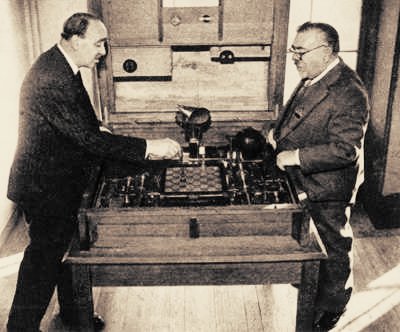


A while ago we reported on the recreation of Kempelen's famous Chess Turk by the Heinz Nixdorf Museum in Paderborn, The Turk was an automaton that played chess. Of course it did not do this on a purely mechanical basis. A human operator was hidden in the contraption.
One would imagine that the first genuing non-human chess player would be an electronic computer. However, a mechanical contraption actually did exist that could play limited positions, long before computers were invented.
Chess, it seems to be, has always been fascinating to people wishing to create machines that behave like humans, or at least the illusion thereof. Baron Wolfgang von Kempelen created his famous Chess Turk back in 1769, and many others after him tried to repeat the awe-inspiring trick by creating similar devices, most notably Charles Hopper's Ajeeb, also known as “The Egyptian”, which during its exhibitions at Coney Island in the United States during the 1894-1904 period is said to have been operated by none other than Harry Pillsbury himself.

In any event, for a long number of years mankind seriously thought that a machine that could play chess would be truly intelligent. And so, entertainers like Von Kempelen and Hopper notwithstanding, many brilliant minds devoted themselves to the creation of such a machine. One would think the first steps in this direction were simply impossible without our modern, digital computers, but one of Spain's most famous engineers of all times knew better.
|

Torres' Aero car which is still operational today
 In
1912 Torres built his chess machine 'Ajedrecista', using electromagnets under
the board to play the endgame rook and king against the lone king. Well, not
precisely play. But the machine could, in a totally unassisted and automated
fashion, deliver mate with King and Rook against King. This was possible regardless
of the initial position of the pieces on the board. For the sake of simplicity,
the algorithm used to calculate the positions didn't always deliver mate in
the minimum amount of moves possible, but it did mate the opponent flawlessly
every time.
In
1912 Torres built his chess machine 'Ajedrecista', using electromagnets under
the board to play the endgame rook and king against the lone king. Well, not
precisely play. But the machine could, in a totally unassisted and automated
fashion, deliver mate with King and Rook against King. This was possible regardless
of the initial position of the pieces on the board. For the sake of simplicity,
the algorithm used to calculate the positions didn't always deliver mate in
the minimum amount of moves possible, but it did mate the opponent flawlessly
every time.
The machine, dubbed El Ajedrecista (Spanish for “the chessplayer”), was built in 1912 and made its public debut during the Paris World Fair of 1914, creating great excitement at the time. It used a mechanical arm to make its moves and electrical sensors to detect its opponent's replies.
In 1920 a second automaton (attributed by some sources to Leonardo's son, Gonzalo), was built that made its plays via magnets located under the board. Both machines still work and are on display at the Colegio de Ingenieros de Caminos, Canales y Puertos in Madrid.

Gonzalo Torres y Quevedoshowing his rook endgame machine to Norbert
Weiner
It may be said that a King and Rook versus King endgame is very simple. By today's engineering standards, the mechanical automatons built by Torres y Quevedo are not precisely earth-shattering. However, they were in their day, more than 90 years ago; and more so considering computers were nowhere near inception. And in fact, because of this and other important contributions, Torres y Quevedo's works are regarded today as major precursors to artificial intelligence and modern computing. And this despite the fact that, due to adverse circumstances, his ideas didn't influence the trade as much as they could have.
Ramón Jiménez is a Dominican software engineer and a chess aficionado.
He hasn't played much chess in recent years, but increasingly enjoys watching,
analysing and attempting to understand GM-level games, of all kinds and styles
(but he prefers furious, decisive games!). He is currently based on the UK,
where he is pursuing advanced postgraduate studies in his area of knowledge.